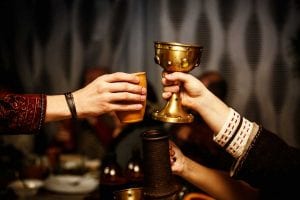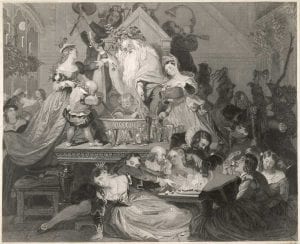December 26, 2020 | By Emily Schuman
For many, the holidays are synonymous with festive beverages of the alcoholic kind. We’re peppered with recommended recipes for cocktails with a holiday twist, eggnog hits the shelves beginning in November, and suddenly breweries are releasing Holiday Ales. These beers, also known as Winter Warmers, Christmas Ales, and Biere de Noel, promise high ABVs and dark and malty profiles spiced with the likes of cloves, cinnamon, and nutmeg—basically all of the spices that are reminiscent of the baked goods probably sitting on the counter. When you start to thumb through the history books, it turns out the tradition for winter or Christmas beers goes further back than you probably realized.

The tradition for holiday beers begins with the Vikings of pre-Christian Scandinavia. Ask someone to describe Vikings, and they will probably say the people who wore the helmets with the horns while sailing and terrorizing Europe during the 10th century. That is only partially true—the helmets were never real—but the vast travel and pillaging definitely was, and that contributes to our story. As Vikings travelled, pillaged, and settled in predominantly Christian lands, they quickly adapted Christian traditions and merged them with their own. One such tradition was the offering of beer to Odin on December 21st during their Jul celebrations. Jul is also sometimes written as “Yule.” See where we’re going? As pagan Vikings adopted Christmas traditions, the festival dedicated to Odin became the festival dedicated to Jesus’ birth, but the tradition to offer up a deep malty beer remained.
King Haakon, who ruled as of the first Christian Vikings from c. 934-961, decreed that every household must brew a Christmas beer for Jul. This was later formalized as a part of the Gulating Law Code. The law instituted by King Haakon required that every single household brew a Christmas beer and the penalty for not brewing was to pay three marks to the Bishop. However, any household that would go three years without brewing and would be forced to give all of its money to the King and the Bishop. To top that off, if you didn’t confess your sin of not brewing, you were kicked out of Norway. That seems like a pretty hefty cost to not brew a beer.
In Viking culture, there was a high value and societal expectation of feasts accompanied by measures of beer to drink. Historical evidence shows that barley was imported to make up for the small amounts grown on arable land. What was produced and purchased was almost exclusively reserved for beer. This shows the value that beer held in Viking society!

Moving forward a couple of hundred years, Tudor England was renowned for its Christmas spectacles. This is when many of our current traditions originated, including the 12 days of Christmas. Tudor England went into celebration mode beginning on the 24th of December and lasted through the New Year.
Feasts were a must, with tables set with Turduckens (true fact!), minced pies and a communal “Wassail Bowl.” This bowl held a gallon of punch. While recipes vary, it was predominately made from hot-ale, spices, and honey. In the bottom of the bowl would be a crust of bread which was given to the most important person in the room–the origins of a toast before a drink! This bowl would be passed around from person to person as a sign of good health. Basically, buying your neighbor a winter warmer is just wishing them good health in the New Year. As the evolution of ale and beer evolved in England, the spiced ale during Christmas remained.
Go to the store to buy a Christmas beer and you’ll see a variety of options on the shelf. There are no guidelines for what makes a holiday beer, but the general consensus is that you’ll be treated to a high ABV, malt forward, rich, sweetly spiced beer that is reminiscent of sitting in front of a fireplace. It will sit heavy in the gullet to keep you fueled through the dark winter days and should be the centerpiece in your festive celebration.